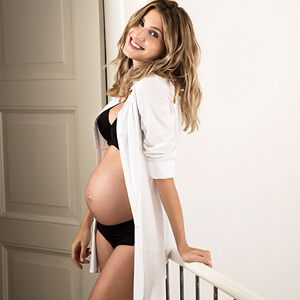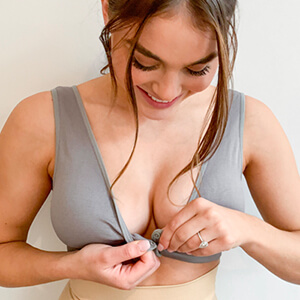
What is a Maternity Bra?
A maternity bra is designed specifically for comfort and support during pregnancy. During the first trimester, a woman’s breasts can undergo a rapid growth with an increase of a few cup sizes. The majority of changes occur within the first 3-4 months of pregnancy and can result in tenderness, sensitivity and a feeling of heaviness in the breast.

How is a Maternity Bra Different From a Regular Bra?
Regular bras are mainly designed for fashion. These generally have underwires, and the fabrics are chosen for fashion reasons and are usually not that stretchy. They often have detailing like lace against the skin which can irritate sensitive skin during pregnancy.
When Should You Start Wearing a Maternity Bra?
If your current bras are becoming too tight then it’s time to look for a maternity bra. If you find yourself constantly adjusting the straps and wish it were just a little looser around the band then it’s time to get a new bra.

How Many Will I Need?
Most women will have three bras: one to wear, one in the wash, and a clean one.
Keep in mind that each pregnancy is different and the body changes will be unique to you. Some find their cup size increases throughout their pregnancy. Also the rib cage expands so you may need to size up a few times.
How Should a Maternity Bra Fit?
- The cup should cover the breast with no ‘spillage’ and no bumps or wrinkles in the fabric.
- The centre section of the bra should lie flat on your chest between your breasts.
- The bra should sit under your breasts to support them and the band should be level with no riding up at the back.
- Try sitting down, and make sure it doesn’t pinch or bunch up.
- When moving your arms, the straps should be comfortable without digging in or falling off your shoulders.
- The bra should fit comfortably when with the hooks closed, preferably on the smallest setting to allow for expansion as your pregnancy advances.
- When trying on a bra, if it causes any discomfort or hassle then look at a different style or brand.

What to Look for in a Good Maternity Bra
Characteristics of a good maternity bra include:
- Hook and Eyes
Maternity bras usually have more rows of hooks and eyes to allow for greater flexibility with your changing body especially as your rib cage expands and contracts.
- Lining
Regular bras generally don’t have lining. Most nursing bras have lining for increased skin sensitivity as well as pockets in which to place nursing pads. Typically a good bra will be double layered
- Stretch Fabrications
Allow for greater comfort and do not constrict the breast allowing for fluctuations in size.
- Straps
Adjustable straps are generally wider for added comfort and so they don’t dig into your shoulder.
- Back Band
A wide back band will offer more comfort and support


What‘s the Difference Between a Maternity and a Nursing Bra?
A maternity bra is designed for support and comfort of your growing breasts during pregnancy and a nursing bra is designed for breastfeeding access without having to remove your bra.
These days, however, many bras are designed for both pregnancy and breastfeeding and the terms are now interchangeable
What is a Sleep Bra?
A sleep bra is designed to offer comfort and support while you sleep. They also help keep nursing pads in place. Generally these bras are soft and wire-free with a pull over style with no uncomfortable clasps at the back. We're so proud to have won bronze for our sleep bras in the Mother&Baby awards.

How Does a Nursing Bra Work?
Pull Aside
These bras have a crossover front in a stretchy fabrication so they easily pull aside to feed. These are most commonly found in sleep bra styles.

Front Opening
This is another common style for a sleep bra. Besides having pull aside nursing access these bras also open at the front allowing for ‘kangaroo care’ or skin-to-skin contact with your baby when feeding.
Studies have found that skin-to-skin holding stabilizes heart and respiratory rates, improves oxygen saturation rates, better regulates an infant's body temperature, and conserves a baby's calories.

Drop Cup
These are the most common types of nursing bras. There is a clasp at the top of the cup which you undo and pull the cup down.
|
Side Sling

There is usually a strip of fabric joining the strap with the base of the bras, called a side sling. This is so you don’t lose the strap and can refasten the clasp easily.
|
A-Frame

For larger cup sizes, there is usually a triangular frame around the cup called an A-frame. This covers more of the breast for feeding and offers more bust support.
|
Why don't Nursing Bras have Underwires?
The concern with a rigid underwire bra is that if the underwire is too tight it could inhibit blood flow and hamper milk production leading to a clogged duct or mastitis. In the first few weeks after the baby's birth when your milk comes in, the size of the breast can increase and decrease as milk is produced and an underwire can cause pressure on the breast when it is fuller.
Why are Seamless Bras so Popular?
Seamless nursing bras are so popular because they are comfortable and provide a smooth look under clothing. They are also good for those with sensitive skin. As these bras are a seamless knit they can stretch a few cup sizes which is essential during those transitional pregnancy stages and when your milk comes in for breastfeeding.

Caring for Your Bras
Generally, a hand wash is the best way to ensure your maternity bras last longer. If you do pop them in the machine make sure to do up the clasps and place in a lingerie wash bag.
Do not tumble dry bras - the heat causes the elastic to break down resulting in shrinkage or to cause them to fall apart. We recommend line drying your bras in the shade.
How do our different maternity and nursing bras compare? Click here for a comparative guide on our different styles.
